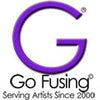
How to Fuse Glass Metal Inclusions
We offer an entire category of Fused Glass Metal Inclusions comprised of Brass or Copper.
Each item offered has been tested for the proper thickness to avoid annealing temperature differences between the glass and metals and to help reduce air bubble they are prepared to be the correct thickness.
There are only a few important tips when working with Fused Glass Metal Inclusions:
- Always clean all metals before trying to fire them between glass layers.
- Make sure the glass cap covers all areas of the glass and does not run out to the edge of the glass.
- Always anneal your glass slowly and best results are attained at a full fuse.
Not all metals will work as a Fused Glass Metal Inclusions. Here is a summary of metals:
- Aluminum will never work as it has a much lower melting temperature than glass.
- Copper or Brass: Thin sheets of Copper, Brass sheets or Mesh metals can be cut, cleaned and then sandwiched between glass layers for added detail.
+ Copper will turn most hues of red to burnt umber.
+ Brass will stay the same color to highlights of red tones. Brass is any alloy of copper and zinc: The proportions of zinc and copper vary widely to create a range of brasses with varying properties. Brass should not be confused with bronze which is principally an alloy of copper and tin. Despite this distinction, some types of brasses are called bronzes.
- It is important to always test fire samples before planning any project. We have done all the testing for you. Each glass metal inclusion we offer to you has been tested and only those that work are provided. We also try to provide you an example picture with each item to give you a better idea of the results to expect.
Note: There are 18 different types/names for brass. The most common are:
- Yellow brass is an American term for 33% zinc brass
- Rich low brass (Tombac) contains 85% copper 15% zinc often used in jewelry applications.
TIP: To control air bubbles between the layers, you can sift clear fine frit on top of the first layer of glass, then add your metals. During the firing, hold at slumping temperature for 30 minutes and then continue your firing. This will help to squeeze out any air bubbles.
This same technique can be done using brass or copper wire too.
Gold and Silver Foils: Very thin foil sheets work best, craft hobby foil. After full fusing the foil becomes permanently affixed to the glass without the need to use any binders. Handle it between two protective sheets or tissue paper or you can cut it into a desired shape (while keeping it between the protective tissue) and then slide it out onto the clean glass.
Gold and Silver "Leaf": Leaf is much more delicate than thin hobby foil. It takes 3 to 4 layers of leaf in order to get good color. Working with leaf takes time and patience.
- Work in an area with NO airflow. The leaf wants to float on any air current and will stick to you and anything else it comes into contact with.
-Try to handle the leaf between the protective sheets. Carefully tear out an extra sheet and then carefully slip it behind the leaf and then tear out the top protective sheet and the leaf between. If you want to cut down the sheets, do so with the protective paper on the top and bottom.
You can simply layer the sheets between the glass layers and fuse them. Then cut the fused glass into shapes to add details or borders to your fused pieces. If you want to try to cut a specific shape try the following. Keep your design very simple. Pick up the two protective sheets with the gold leaf in between. Cut your design through all three layers. Apply Water Friendly Medium with a brush on clean glass in the basic shape of your design. Then, carefully slide back the bottom sheet exposing a narrow edge of the cut gold leaf. Gently touch the gold to the medium on the glass and slide the bottom sheet away.
What you are trying to do is to float the gold on top of the water friendly medium. DO NOT TOUCH the gold with your fingers. If it is necessary to smooth the leaf use a very soft brush. Let that dry, then carefully with light touches add more medium to the top of the first leaf in your desired pattern.
Repeat the procedure for floating the 2nd leaf on top of the 1st leaf. Let this dry and then repeat 1 or 2 more times. If you need to clean up edges, wait until the medium is dry and then use an Exacto knife to trim away any excess
- Choosing a selection results in a full page refresh.
Newsletter
Quick links
Our mission
Promote the Future of Custom Art Glass by providing inspiration thru sharing creativity and knowledge.
Contact Us
Follow us
!
